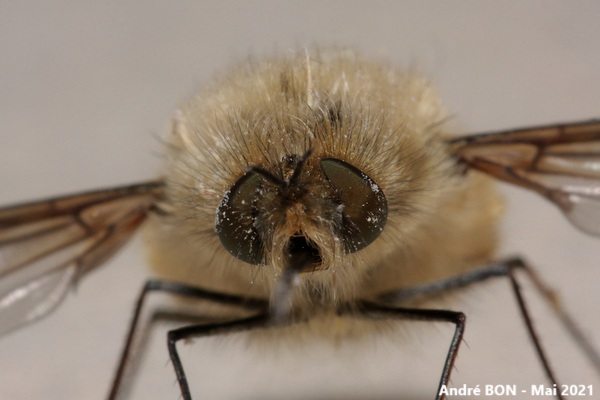


| Bombylius venosus (Mikan, 1796) |



|
|
Scientific name: Bombylius venosus (Mikan, 1796) Common name: French name: Order: Diptera Family: Bombyliidae Wingspan : 8 to 11 mm. Biotope: Grasslands, savannahs and steppes. Geographic area: Europe, Near-East. Observation period : April to June. |
Bombyliidae are stocky and often hairy dipterans that can resemble bumblebees or bees. Bombyliidae of the Bombylius genus have a long, rigid, pointing forward proboscis. The antennae are close together at the base. The hind femurs are spinous on their antero-internal side. The small transverse vein (r-m) is located one third of the discal cell. As a result, the first basal cell closest to the costal edge is longer than the second. Bombyliidae of the Systoechus genus have the two basal cells of the same length. The r-m vein is close to the base of the discal cell. There are many species that are very difficult to identify on photos, but this is nevertheless possible for Bombylius venosus. This last species has yellowish fur mixed with some black bristles, paler on the ventral side. The wings are hyaline and slightly yellowed at the base. There are long black bristles that surround the back of the eyes (front view required). There are also two or three strong black bristles just ahead of the wing base. Bombylius cinerascens does not have this crown of long black bristles behind the eyes. |
| [To know more about the Bombylius venosus] [Next picture] [Top] |

|
Here is a cooperative subject, namely a Bombylius posed motionless except for a constant little agitation of the wings. This photo allows us to see at least one robust black bristle just ahead of the wing which is slightly yellowish at its base. |
| [To know more about the Bombylius venosus] [Next picture] [Previous picture] [Top] |

|
This other photo allows you to see the location of the small transverse vein which confirms the Bombylius genus. You can also clearly see the spines of the hind femurs. |
| [To know more about the Bombylius venosus] [Previous picture] [Top] |

|
Finally, this last photo, from the front, shows the crown of long black bristles behind the eye. Everything matches to identify Bombylius venosus. |